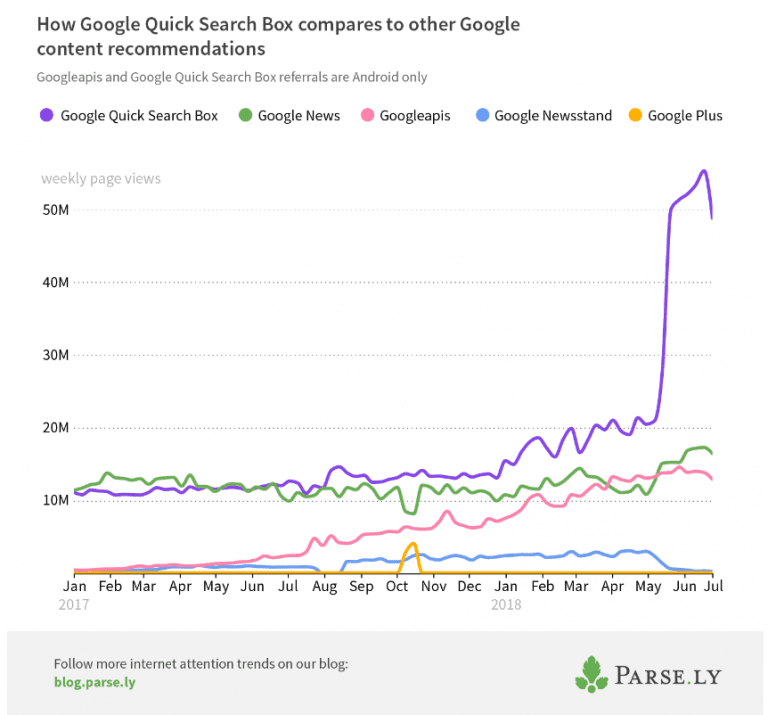|
Getting your Trinity Audio player ready...
|
Whenever we see a chart like this, our analysts quickly start asking questions. Big spikes usually mean some sort of change, new product, or initiative at a platform that affects journalists and media companies. The problem is,

In this case, the data led us to something called Google Quick Search Box. As our Senior Audience Development Solutions Manager, Kelsey Arendt, explains: “GQSB was previously understood to be only organic search from the search bar widget on mobile devices, but now it’s a blend of search box and recommended content.”
The referrer now sends traffic from:
- “View Related Pages.” This appears in a Google webview—not Chrome—on both AMP and non-AMP pages.
- “Check out your feed” at the bottom of search inputs. This takes you to “interest-based” content cards.
- Left-of-home swipe cards. (Note: These cards aren’t related to the googleapis referrer, and we’ve clarified that in this post.)
And so another Google initiative could be affecting how your content gets shown to audiences. Though there might be benefits this time around.
Considering the effect of personalization on readership
Beyond the fact that we see (again) the power of platforms to influence how audiences find premium content, the data also shows what an impact personalization of content can have.
According to Parse.ly data, internally referred traffic sends more views to articles than all of social media. This includes home and sections pages, as well as any recirculating traffic sent from article to article. Increasing these views by showing even better personalized articles has huge potential.
So when it comes to content, what kind of personalization works, and how do you test it?
Adapting personalization to your audience
Personalization can mean a lot of things when it comes to tactical execution. Does it mean that each reader sees content uniquely based on their reading history? Or maybe based on the section or article the user is seeing that moment?
There isn’t a one-size-fits all solution for this, and media companies should be testing and adapting their personalization strategies for their audiences. Much like technology developers test user experience, this should not be a static choice that is made once for all audiences.
Last year, Setareh Baig, a then graduate school intern from NYU’s Studio 20 program, tested how this would work in practice. She interviewed the product teams at The New Yorker and The Intercept and did user testing.
Setareh found that first-time visitors to these sites were most interested in reading more posts when they knew these articles had been the most shared. From her research:
“These readers are very interested in what’s being shared. They valued personalization tailored to stories that are relevant in conversations with peers. They want news stories that other people want to know about and take proactive action on. Whereas time on page is passive, they want to be given stories that other people were inspired and driven to do something about.”
Since The New Yorker team cares deeply about subscribers as well, other user tests could be implemented, testing whether returning visitors had the same behavior, or whether they were more likely to want to read a story they knew other subscribers had spent time with.
We’re keeping our eye on the trends and traffic that Google sends publishers’ way. We’re also encouraged to see publishers take what works and adapt to their own readers. Here’s to seeing more spikes of interested readers in the future.
By Clare Carr, Vice President of Marketing—Parse.ly@clareondrey
Republished with kind permission of Digital Content Next, advancing the future of trusted content



